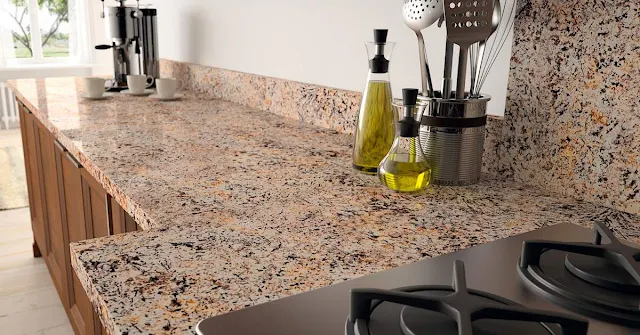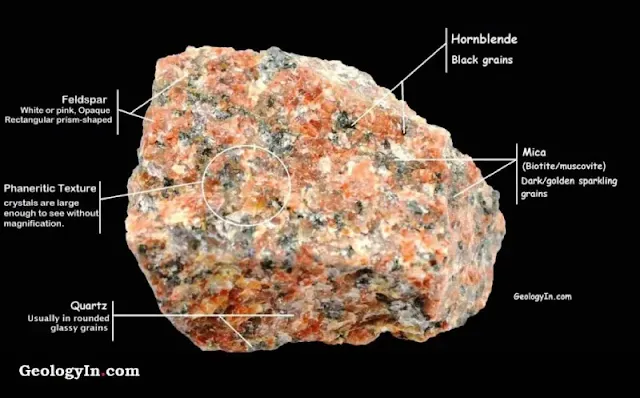What Is Granite And How Is It Formed?
Granite
Granite is a coarse-grained intrusive igneous rock made up of primarily quartz, feldspar, micas, amphiboles, and a mixture of additional trace minerals. These minerals and their variation in abundance and alteration give granite the numerous colors and textures we see in granite countertops. Formally, granite is a plutonic rock that is composed of between 10 to 50% quartz (typically semi-transparent white) and 65 to 90% total feldspar (typically a pinkish or white hue).
Granite is an intrusive igneous rock, which means it was formed in place during the cooling of molten rock. Generally, the slower the molten rock cooled, the larger it’s mineral crystals with K-Feldspar megacrysts forming in special circumstances greater than 5cm. During formation of granite it is buried below kilometers of rock and sediment necessary to produce enough heat to melt rock.
Granite Summary
- Group: plutonic
- Colour: variable but typically light-coloured.
- Texture: phaneritic (medium to coarse grained).
- Mineral content: orthoclase, plagioclase and quartz (generally more orthoclase than plagioclase), often with smaller amounts of biotite, muscovite or amphibole ( hornblende).
Of course, the granite we see today is near surface, and thus at some point was uplifted, causing overlying sediment to be shed via erosion. This transition from high pressure and temperature to atmospheric temperature and pressure can cause the granite to slightly expand and crack. This, in addition to seasonal variations in temperature can leave you with a weakened and less desirable granite to use for countertops.
Granite composition
Granite is composed mainly of quartz and feldspar with minor amounts of mica, amphiboles, and other minerals. This mineral composition usually gives granite a red, pink, gray, or white color with dark mineral grains visible throughout the rock.
Granite is classified according to the QAPF diagram for coarse grained plutonic rocks and is named according to the percentage of quartz, alkali feldspar (orthoclase, sanidine, or microcline) and plagioclase feldspar on the A-Q-P half of the diagram.
True granite (according to modern petrologic convention) contains both plagioclase and alkali feldspars. When a granitoid is devoid or nearly devoid of plagioclase, the rock is referred to as alkali feldspar granite. When a granitoid contains less than 10% orthoclase, it is called tonalite; pyroxene and amphibole are common in tonalite.
How is granite formed
Granite formed in a number of different situations. Some granite was generated in zones of rifted continental or oceanic crust, but most granite was generated in zones of collision between continents and oceanic crust, and where continents were amalgamated.
Granite formed by two different processes: by fractional crystallization of basaltic magma; and by melting older continental crust. Between these end members, there is a spectrum of hybrid processes, including mixing of basaltic and granitic magmas, and contamination of basaltic magma by partial melts of different kinds of continental crust
A granite containing both muscovite and biotite micas is called a binary or two-mica granite. Two-mica granites are typically high in potassium and low in plagioclase, and are usually S-type granites or A-type granites.
Granite has a felsic composition and is more common in recent geologic time in contrast to Earth's ultramafic ancient igneous history. Felsic rocks are less dense than mafic and ultramafic rocks, and thus they tend to escape subduction, whereas basaltic or gabbroic rocks tend to sink into the mantle beneath the granitic rocks of the continental cratons. Therefore, granitic rocks form the basement of all land continents.
Geochemical origins
Granitoids have crystallized from magmas that have compositions at or near a eutectic point (or a temperature minimum on a cotectic curve). Magmas will evolve to the eutectic because of igneous differentiation, or because they represent low degrees of partial melting. Fractional crystallisation serves to reduce a melt in iron, magnesium, titanium, calcium and sodium, and enrich the melt in potassium and silicon – alkali feldspar (rich in potassium) and quartz (SiO2), are two of the defining constituents of granite.
Granitization
Granitization is a process by which preexisting rocks are transformed into granite-like rocks.
Granitization is an important process in the formation of the Earth's crust. It is thought to be responsible for the formation of large areas of granite-rich rocks, such as the Canadian Shield and the Baltic Shield. Granitization can also play a role in the formation of ore deposits.
Granitization is a fascinating process that is still not fully understood. However, it is clear that it is an important process in the evolution of the Earth's crust.
Types of granitization
This can happen through a variety of mechanisms, including:
Metamorphism: Metamorphism is the process by which rocks are changed by heat and pressure. In the case of granitization, the heat and pressure can cause the preexisting rocks to melt partially, and the resulting magma can then crystallize to form granite.
Magmatic intrusion: Magmatic intrusion is the process by which magma is injected into preexisting rocks. The magma can then heat and alter the surrounding rocks, causing them to become more granitic in composition.
Hydrothermal alteration: Hydrothermal alteration is the process by which water-rich fluids circulate through rocks and cause them to change composition. In the case of granitization, the hydrothermal fluids can carry dissolved minerals that can be deposited in the rocks, causing them to become more granitic in composition.
The relative importance of these different mechanisms in granitization is still debated. However, it is clear that granitization is a complex process that can involve a variety of factors.
Evidences that support the process of granitization:
- The presence of granitic rocks in areas that are not known to have had igneous activity: This suggests that the granites may have formed from preexisting rocks through the process of granitization.
- The presence of metasomatic minerals in granitic rocks: These minerals are thought to have formed when fluids reacted with preexisting rocks.
- The presence of evidence of melting in granitic rocks: This suggests that the rocks may have melted during the process of granitization.
Granite Uses
Granite is a popular and versatile material that has been used for centuries for a wide variety of purposes. Its unique properties, including its durability, hardness, and resistance to heat and stains, make it an ideal choice for both interior and exterior applications. Here are some of the most common uses of granite:
Construction: Granite is a common material used in construction for its strength and durability. It is often used for building foundations, walls, floors, and other structural elements. Granite is also a popular material for exterior cladding, as it can withstand the elements and maintain its appearance for many years.
 |
| Granite countertop Kitchen |
Countertops: Granite countertops are a popular choice for kitchens and bathrooms due to their beauty, durability, and easy maintenance.
Flooring: Granite flooring is a luxurious and durable choice for both interior and exterior spaces. Granite is resistant to wear and tear, making it a good choice for high-traffic areas. It is also easy to clean and maintain. Granite flooring is available in a variety of finishes, including polished, honed, and flamed.
Monuments and memorials: Granite monuments can last for centuries, making them a lasting tribute to loved ones or historical events.
Other uses: Granite is also used for a variety of other purposes, including landscaping, paving, and sculpture. It is a popular choice for landscaping due to its beauty and durability. Granite paving is often used in sidewalks, patios, and walkways. Granite is also used to create a variety of sculptures, including statues, fountains, and benches.
.jpg) |
| Cubic Granite Samples |
See also:
Granite Vs Gabbro: Similarities and Differences
How Is Orbicular Granite Formed?



%20(1).webp)






